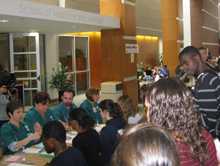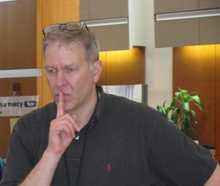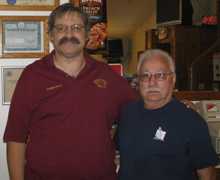Doctors Face a Language Barrier
October 2009

Aspiring doctors at the University of Rochester’s School of Medicine and Dentistry wait for an evaluation during the Deaf Strong Hospital role-playing exercise. Many students said they gained valuable experience that will help them serve their own future patients.
It’s an extraordinary Friday morning in August. Inside the University of Rochester’s School of Medicine and Dentistry, a transformation is happening. Dozens of volunteers wearing aqua surgical scrub shirts are setting up a role-playing exercise that includes a mock waiting room, emergency room, psychiatrist’s office, pharmacy, and station for consulting with social workers. The school’s cavernous atrium becomes Deaf Strong Hospital, where the staff are deaf and the patients are hearing.
Deaf Strong Hospital was established by the school’s medical students in 1998. The yearly event is now spearheaded by the CDC- funded National Center for Deaf Health Research (NCDHR), one of 35 Prevention Research Centers (PRCs) across the country. Each center works with underserved communities to identify and address their most pressing public health needs; the Rochester PRC works with the area’s deaf community. Deaf Strong Hospital gives medical students and the local deaf community an opportunity to contribute to the training of future doctors.
“Exercises like Deaf Strong Hospital teach medical students that language differences limit the ability of clinicians to do their job well,” says Steven Barnett, MD, a researcher with NCDHR and a family physician who is hearing. In this case, the volunteer staff use American Sign Language (ASL), but the lesson applies to any language other than English.

No Voices Allowed
Matthew Starr, MPH, the researchers used a “back-translation,” or “bi-directional translation,” process to be sure the original English-based BRFSS questions from the 2006 survey questionnaire were accurately translated into ASL for the video. Deaf and hearing team members, fluent in both English and ASL, translated the original questions and responses into ASL and videotaped them. Then, independent bilingual reviewers watched the video content and translated it back into written English, so other reviewers could compare it with the original English-text questions and responses. Any differences between the two written versions were noted so appropriate corrections could be made. The team followed a similar process for the EBS survey.
The researchers loaded the survey program and all the video clips into computer kiosks that have a touch-screen format. To ensure only one participant answers at a time and that the responses remain private, a user stands behind a curtain, watches the video or reads the text, then responds by touching the screen.
When the kiosks were ready, the researchers made the survey available to members of Rochester’s deaf community. More than 300 respondents were surveyed in Rochester, at locations including a recreation club for deaf residents and the PRC office as well as during community events, such as the 40th reunion of graduates of the National Technical Institute for the Deaf. If some participants wanted to take the survey but could not get transportation to a survey site, the researchers took the kiosks to the participants’ homes.
The basic survey asks 98 questions, but the computer presents different questions based on the participant’s responses, performing age- and gender-appropriate questioning. The team added unique survey items to collect deaf-related characteristics, such as age-at-onset of deafness. It was administered from March to September 2008. Results showed that most of the deaf respondents in Rochester are white and may have disproportionately low household incomes considering their high level of education. Most have been deaf since birth, and a third of the respondents had a deaf parent or sibling. Analyses are ongoing, and the results will be compared with results from a 2006 BRFSS general-population survey taken by telephone in the county where Rochester is located. The PRC researchers say they will continue to refine their survey technology and techniques so one day, deaf people can routinely participate in surveys. This advance could help researchers survey deaf communities in other regions of the country and thereby compare and address their public health needs.
Community-Research Partners Shape the Future of Deaf Health
At a series of town hall meetings, researchers and community members agreed that obesity, suicide, and relationship violence were the high-priority health topics that emerged from preliminary analysis of the survey results. The researchers and their community partners will develop interventions to address these issues, starting with obesity, during the PRC’s 2010 to 2015 grant cycle.
Rochester PRC director Thomas Pearson, MD, MPH, PhD, who is hearing, says future interventions may include training deaf people to be community health workers. Community education is an area of particular interest to the NCDHR, adds Dr. Smith, because deaf people often find it difficult to get accurate and useful health and medical information.
“We have to learn from the deaf community what we can’t hear on the radio or television,” says Dr. Smith, the pediatrician. “We have to get that from one another or it becomes a gap that grows and grows.”

Community Service
Steven DeBottis (left), president of the Rochester Recreation Club for the Deaf and Chuck DiVincenzo, a former club president, say they are always looking for experts to share their knowledge with club members. The club center was one of the sites where Rochester’s deaf community participated in a health survey, as part of a study being conducted by the National Center for Deaf Health Research and its deaf community partners.
The PRC has been a big help in providing health education, says Steven DeBottis, president of the Rochester Recreation Club for the Deaf—a resource that has been the hub of Rochester’s deaf community since 1945. Not only was it one of the sites where the deaf health survey was administered, but it is a place where members can find information they need for their everyday lives, he says. Members packed the recreation center on the nights deaf NCDHR physicians came and used ASL to answer questions and lecture on staying healthy.
Clubs and other organizations really can help deaf communities stay informed about health, adds Dr. Smith. He says he recently traveled to another state to meet with members of other deaf communities. A group of deaf senior citizens in the state capital, he observed, were key sources of information and kept their community informed, much like the recreation club does in Rochester. Members of the city’s deaf community were especially savvy about keeping their hearts healthy.
“I was so impressed at their level of knowledge,” says Dr. Smith. But he notes that in large cities, it may be easy for deaf residents to help keep each other informed. When Dr. Smith traveled to a small, rural town, deaf people there tended to be isolated and could not get together regularly to share stories and information. The difference was dramatic, Dr. Smith says, adding that he hopes that the work at NCDHR will help identify the most important health information to communicate and which deaf communities need it the most.
The students at the University of Rochester’s School of Medicine and Dentistry are striving to keep the deaf community informed about health. They work with deaf community members to create educational videos.
“We have to bring deaf people together,” says Dr. Smith. “We need to find each other.”
- Page last reviewed: January 24, 2012
- Page last updated: July 28, 2016
- Content source:


 ShareCompartir
ShareCompartir